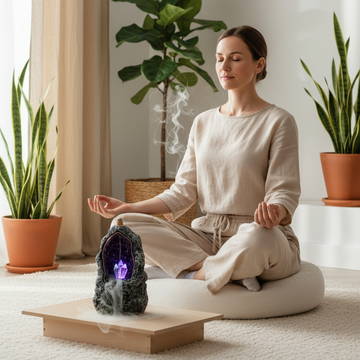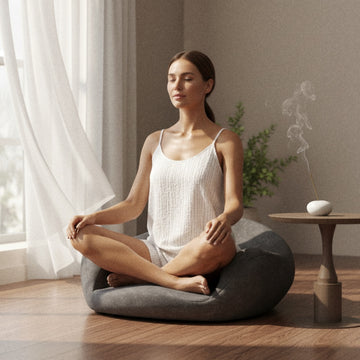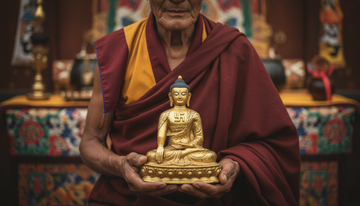Opening: My truce with insomnia
Many nights felt like chasing an invisible bird: the harder I tried, the farther it flew. I thought sleeping well was an exam I had to ace. Then I learned to rest attention on the cool thread of breath at my nostrils, to do a simple body scan under the blanket. I didn’t pass out immediately—but for the first time I stopped fighting the night.
This is my human, workable insomnia meditation / meditation for sleep guide—written for you, and for the version of me who finally learned to make room for sleep.
1) Why meditation can help sleep (plain-language mechanism)
Gentle, regular breathing and a steady posture invite the nervous system to lean from alert toward repair; attention placed on breath awareness or body sensations keeps you from being carried by worry-memory-planning loops; and, crucially, you replace control with allowing—the true doorway of meditation for sleep.
Not medical advice; if you have persistent issues, work with a professional. Meditation is a kind helper, not a replacement for care.
2) Sleep hygiene tweaks that matter
Dim lights an hour or two before bed; keep the room slightly cool; try white/pink noise or nature sounds; keep a consistent wake time; reduce caffeine later in the day and avoid alcohol near bedtime; and reframe the goal from “sleep perfectly” to “make room for sleep.”
3) Four core sleep-meditation methods (step by step)
Body Scan for Sleep / Insomnia
Posture: side-lying or supine; a pillow under the knees can help.
Script (10–15 min): three longer exhales; attend to toes (cool/warm, tight/soft, contact/pulse) for 2–3 breaths each spot, moving toes→calves→knees→thighs→pelvis→belly→chest→shoulders→hands→neck→face→scalp; when you drift, return to the exact spot you’re on; finish with a light sweep from the feet.
The aim isn’t to knock out; it’s to create conditions where sleep can arrive.
4-7-8 Breathing / Box Breathing
4-7-8: inhale 4 → hold 7 → exhale 8 (×4). If holding feels edgy, shorten or skip.
Box: 4-4-4-4 for 6–8 rounds.
Let exhalation be the star—an easy brake for the nervous system.
Progressive Muscle Relaxation (PMR)
Gently tense then release: feet→calves→thighs→glutes→belly→back→fists→forearms→upper arms→shoulders→neck→face; 3–5 sec tension, then melt on the exhale. Perfect for “wired-but-tired” nights.
Yoga Nidra (starter)
Do a rotation of consciousness: swiftly rotate attention across body parts (thumb→fingers→hand→arm…→feet→legs→torso→face). No forcing—just an unbroken, easy flow, like rolling down a gentle hill.
4) Scenario-based fixes
Trouble falling asleep: 2–3 minutes of 4-7-8 or Box, then Body Scan.
Middle-of-the-night awakening: don’t check the clock; three longer exhales; restart the scan from the soles; if still stuck, sip water, crack a window, and return.
Early waking: no panic, no forcing; do 10 minutes of Yoga Nidra. Even if you don’t sleep again, you’re repairing.
Racing thoughts: use light labeling (“thinking/worry/planning/memory”) → return to breath or soles; if needed, sit up for a five-minute mini-sit and lie back down.
Phone temptation: leave it an arm’s length away; keep a warm lamp and a pen-and-paper “think tomorrow” note instead.
5) 14-day starter + 8-week ramp
14-day starter (10–15 min/night, plus tiny daytime reps)
D1–3: Body scan 10 min before bed; 3-min breath anytime daytime.
D4–6: add 4-7-8 (4 rounds) before the scan; daytime 60-sec shoulders + 3 longer exhales.
D7–10: add PMR (6–8 groups) every other night; middle-of-the-night = restart from feet.
D11–14: add Yoga Nidra 10 min (swap with PMR if you like).
8-week ramp (make it your mental toothbrush)
W1–2: fixed bedtime flow: exhale-focused breath 3 min → body scan 10 min.
W3–4: add one three-minute meditation in the day; adjust light & temperature.
W5–6: Yoga Nidra 1–2×/week; reduce evening information intake.
W7–8: micro-tune: trouble falling → more exhale-centric work; early waking → more Nidra; anxious re-awakening → label + return.
How long to see results? Often 2–4 weeks to descend more easily, 8–12 for steadier shifts.
6) Self-tracking that actually helps
Sleep latency (min); nocturnal awakenings / time to return; morning energy (1–10); which practices you did (4-7-8 / body scan / PMR / Nidra / guided meditation for sleep); caffeine/alcohol flags.
Watch trends over 7–10 days; don’t grade yourself on a single night.
7) FAQ (long-tails woven in)
Morning vs night meditation? Night for sleep; a tiny daytime practice lowers nighttime friction.
Guided meditation for sleep? Great early on—transition toward self-guided scripts.
Noise choices? Stable, lyric-free, very low volume; the best sound is the one you forget.
Sit or lie down? Lie down for sleep practice; if too drowsy, sit 5 min first, then lie down.
Alcohol for sleep? It fragments sleep—skip.
On meds or clinical concerns? Follow medical guidance; keep meditation as a companion, not a substitute.
8) My reflections: from “chasing sleep” to “leaving room for it”
One hard night I almost reached for my phone. Instead, I rested a hand on my belly, did dozens of easy, longer exhales, and began a body scan from my toes. I didn’t knock out instantly—but I stopped fighting myself.
Insomnia stopped being a personal failure. It became a message: “I’m tired; I’m tense.” My job was to place my heart on the breath and leave space. Often, sleep walks back like an old friend who knows the door is unlocked.
Closing
Meditation doesn’t force sleep; it grows the conditions where sleep happens. Once you know you can return—to breath, to soles, to this moment—you stop fearing long nights. That’s the quiet gift of Meditation for Sleep / Insomnia.













